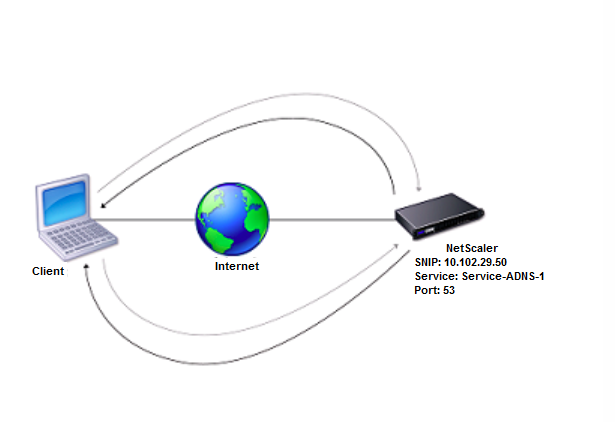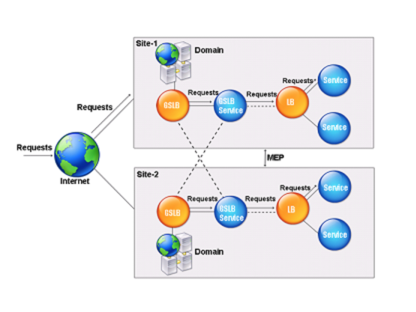-
Getting Started with Citrix ADC
-
Deploy a Citrix ADC VPX instance
-
Install a Citrix ADC VPX instance on Microsoft Hyper-V servers
-
Install a Citrix ADC VPX instance on Linux-KVM platform
-
Prerequisites for Installing Citrix ADC VPX Virtual Appliances on Linux-KVM Platform
-
Provisioning the Citrix ADC Virtual Appliance by using OpenStack
-
Provisioning the Citrix ADC Virtual Appliance by using the Virtual Machine Manager
-
Configuring Citrix ADC Virtual Appliances to Use SR-IOV Network Interface
-
Configuring Citrix ADC Virtual Appliances to use PCI Passthrough Network Interface
-
Provisioning the Citrix ADC Virtual Appliance by using the virsh Program
-
Provisioning the Citrix ADC Virtual Appliance with SR-IOV, on OpenStack
-
Configuring a Citrix ADC VPX Instance on KVM to Use OVS DPDK-Based Host Interfaces
-
-
Deploy a Citrix ADC VPX instance on Microsoft Azure
-
Network architecture for Citrix ADC VPX instances on Microsoft Azure
-
Configure multiple IP addresses for a Citrix ADC VPX standalone instance
-
Configure a high-availability setup with multiple IP addresses and NICs
-
Configure a high-availability setup with multiple IP addresses and NICs by using PowerShell commands
-
Configure HA-INC nodes by using the Citrix high availability template with Azure ILB
-
Configure address pools (IIP) for a Citrix Gateway appliance
-
-
Upgrade and downgrade a Citrix ADC appliance
-
Solutions for Telecom Service Providers
-
Load Balance Control-Plane Traffic that is based on Diameter, SIP, and SMPP Protocols
-
Provide Subscriber Load Distribution Using GSLB Across Core-Networks of a Telecom Service Provider
-
Authentication, authorization, and auditing application traffic
-
Configuring authentication, authorization, and auditing policies
-
Configuring Authentication, authorization, and auditing with commonly used protocols
-
Use an on-premises Citrix Gateway as the identity provider for Citrix Cloud™
-
Troubleshoot authentication issues in Citrix ADC and Citrix Gateway with aaad.debug module
-
-
-
-
-
-
Persistence and persistent connections
-
Advanced load balancing settings
-
Gradually stepping up the load on a new service with virtual server–level slow start
-
Protect applications on protected servers against traffic surges
-
Retrieve location details from user IP address using geolocation database
-
Use source IP address of the client when connecting to the server
-
Use client source IP address for backend communication in a v4-v6 load balancing configuration
-
Set a limit on number of requests per connection to the server
-
Configure automatic state transition based on percentage health of bound services
-
-
Use case 2: Configure rule based persistence based on a name-value pair in a TCP byte stream
-
Use case 3: Configure load balancing in direct server return mode
-
Use case 6: Configure load balancing in DSR mode for IPv6 networks by using the TOS field
-
Use case 7: Configure load balancing in DSR mode by using IP Over IP
-
Use case 10: Load balancing of intrusion detection system servers
-
Use case 11: Isolating network traffic using listen policies
-
Use case 12: Configure Citrix Virtual Desktops for load balancing
-
Use case 13: Configure Citrix Virtual Apps™ for load balancing
-
Use case 14: ShareFile wizard for load balancing Citrix ShareFile
-
-
-
-
-
Authentication and authorization
-
-
Configuring a CloudBridge Connector Tunnel between two Datacenters
-
Configuring CloudBridge Connector between Datacenter and AWS Cloud
-
Configuring a CloudBridge Connector Tunnel Between a Datacenter and Azure Cloud
-
Configuring CloudBridge Connector Tunnel between Datacenter and SoftLayer Enterprise Cloud
-
Configuring a CloudBridge Connector Tunnel Between a Citrix ADC Appliance and Cisco IOS Device
-
CloudBridge Connector Tunnel Diagnostics and Troubleshooting
This content has been machine translated dynamically.
Dieser Inhalt ist eine maschinelle Übersetzung, die dynamisch erstellt wurde. (Haftungsausschluss)
Cet article a été traduit automatiquement de manière dynamique. (Clause de non responsabilité)
Este artículo lo ha traducido una máquina de forma dinámica. (Aviso legal)
此内容已经过机器动态翻译。 放弃
このコンテンツは動的に機械翻訳されています。免責事項
이 콘텐츠는 동적으로 기계 번역되었습니다. 책임 부인
Este texto foi traduzido automaticamente. (Aviso legal)
Questo contenuto è stato tradotto dinamicamente con traduzione automatica.(Esclusione di responsabilità))
This article has been machine translated.
Dieser Artikel wurde maschinell übersetzt. (Haftungsausschluss)
Ce article a été traduit automatiquement. (Clause de non responsabilité)
Este artículo ha sido traducido automáticamente. (Aviso legal)
この記事は機械翻訳されています.免責事項
이 기사는 기계 번역되었습니다.책임 부인
Este artigo foi traduzido automaticamente.(Aviso legal)
这篇文章已经过机器翻译.放弃
Questo articolo è stato tradotto automaticamente.(Esclusione di responsabilità))
Translation failed!
Configure the Citrix® ADC as an ADNS server
You can configure the ADC appliance to function as an authoritative domain name server (ADNS) for a domain. As an ADNS server for a domain, the Citrix ADC resolves DNS requests for all types of DNS records that belong to the domain. To configure the Citrix ADC to function as an ADNS server for a domain, you must create an ADNS service and configure NS and Address records for the domain on the Citrix ADC. The ADNS service can be configured using the subnet IP address (SNIP) or a separate IP address. The following topology diagram shows a sample configuration and the flow of requests and responses.
Figure 1. Citrix ADC as an ADNS

The following table shows the parameters that are configured for the ADNS service illustrated in the preceding topology diagram.
| Entity type | Name | IP address | Type | Port |
| ADNS Service | Service-ADNS-1 | 10.102.29.51 | ADNS | 53 |
Table 1. Example of ADNS Service Configuration
To configure an ADNS setup, you must configure the ADNS service. For instructions on configuring the ADNS service, see “Load balancing”.
During DNS resolution, the ADNS server directs the DNS proxy or local DNS server to query the Citrix ADC for the IP address of the domain. Because the Citrix ADC is authoritative for the domain, it sends the IP address to the DNS proxy or local DNS server. The following diagram describes the placement and role of the ADNS server in a GSLB configuration.
Figure 2. GSLB Entity Model

Note: In ADNS mode, if you remove SOA and ADNS records, the following do not function for the domain hosted by the Citrix ADC: ANY query (for more information about the ANY query, see DNS ANY query), and negative responses, such as NODATA and NXDOMAIN.
Create an ADNS service
An ADNS service is used for global service load balancing. For more information about creating a GSLB setup, see “Global server load balancing”. You can add, modify, enable, disable, and remove an ADNS service. For instructions on creating an ADNS service, see Configure services.
Note: You can configure the ADNS service to use SNIP or any new IP address.
When you create an ADNS service, the Citrix ADC responds to DNS queries on the configured ADNS service IP and port.
You can verify the configuration by viewing the properties of the ADNS service You can view properties such as name, state, IP address, port, protocol, and maximum client connections.
Configure the ADNS setup to use TCP
By default, some clients use the User Datagram Protocol (UDP) for DNS, which specifies a limit of 512 bytes for the payload length of UDP packets. To handle payloads that exceed 512 bytes in size, the client must use the Transmission Control Protocol (TCP). To enable DNS communications over TCP, you must configure the Citrix ADC appliance to use the TCP protocol for DNS. The Citrix ADC then sets the truncation bit in the DNS response packets. The truncation bit specifies that the response is too large for UDP and that the client must send the request over a TCP connection. The client then uses the TCP protocol on port 53 and opens a new connection to the Citrix ADC. The Citrix ADC listens on port 53 with the IP address of the ADNS service to accept the new TCP connections from the client.
To configure the Citrix ADC to use the TCP protocol, you must configure an ADNS_TCP service. For instructions on creating an ADNS_TCP service, see Load balancing.
Important
To configure the Citrix ADC to use UDP for DNS and use TCP only when the payload length of UDP exceeds 512 bytes, you need to configure the ADNS and ADNS_TCP services. The IP address of the ADNS_TCP service must be same as the IP address of the ADNS service.
Add DNS resource records
After you create an ADNS service, you can add DNS records. For instructions on adding DNS records, see Configure DNS resource records.
Remove ADNS services
For instructions on removing services, see Load balancing
Configure domain delegation
Domain delegation is the process of assigning responsibility for a part of the domain space to another name server. Therefore, during domain delegation, the responsibility for responding to the query is delegated to another DNS server. Delegation uses NS records.
In the following example, sub1.abc.com is the subdomain for abc.com. The procedure describes the steps to delegate the subdomain to the name server ns2.sub1.abc.com and add an Address record for ns2.sub1.abc.com.
To configure domain delegation, you need to perform the following tasks, which are described in the sections that follow:
- Create an SOA record for a domain.
- Create an NS record to add a name server for the domain.
- Create an Address record for the name server.
- Create an NS record to delegate the subdomain.
- Create a glue record for the name server.
Create an SOA record
For instructions on configuring SOA records, see Create SOA records for authoritative information.
Create an NS record for a name server
For instructions on configuring an NS record, see Create NS records for an authoritative server. In the Name Server drop-down list, select the primary authoritative name server, for example, ns1.abc.com.
Create an address record
For instructions on configuring Address records, see Create address records for a domain name. In the Host Name and IP address text boxes, type the domain name for the DNS Address record and the IP address, for example, ns1.abc.com and 10.102.11.135, respectively.
Create an NS record for domain delegation
For instructions on configuring NS records, see Create NS records for an authoritative server. In the Name Server drop-down list, select the primary authoritative name server, for example, ns2.sub1.abc.com.
Create a glue record
NS records are usually defined immediately after the SOA record (but this is not a restriction.) A domain must have at least two NS records. If an NS record is defined within a domain, it must have a matching Address record. This Address record is referred to as a glue record. Glue records speed up DNS queries.
For instructions on adding glue records for a subdomain, see the procedure for adding an Address (A) record, Configure DNS resource records.
For instructions on configuring Address records, see Create address records for a domain name. In Host Name and IP address text boxes, type the domain name for the DNS Address record and the IP address, for example, ns2.sub1.abc.com and 10.102.12.135, respectively.
Share
Share
This Preview product documentation is Cloud Software Group Confidential.
You agree to hold this documentation confidential pursuant to the terms of your Cloud Software Group Beta/Tech Preview Agreement.
The development, release and timing of any features or functionality described in the Preview documentation remains at our sole discretion and are subject to change without notice or consultation.
The documentation is for informational purposes only and is not a commitment, promise or legal obligation to deliver any material, code or functionality and should not be relied upon in making Cloud Software Group product purchase decisions.
If you do not agree, select I DO NOT AGREE to exit.